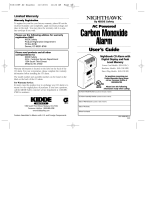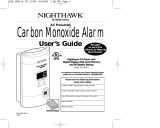Operating and Installation Instructions
15
• This alarm is interconnect compatible with the following
alarms and accessories:
– Smoke alarms: 1235, 1275, 1276, 1285, 1296, i12020,
i12040, i12060, i12080, PE120, PI2000, PI2010, KN-
COSM-IB, KN-COSM-I, KN-SMFM-I and RF-SM-ACDC.
Firex: 4618, 4518, 4480, 460, and 484. Kidde/Firex:
i4618, i4718, and i5000.
– Heat alarm: HD135°F
– CO alarms: KN-COB-IC, KN-COP-IC, KN-COPF-i
– Relay modules: 120X, SM120X, CO120X
– Strobe Light: SL177i
See User’s Guides for specific application information.
• For more information about compatible interconnect units
and their functionality in an interconnect system, visit our
web site at www.kidde.com.
HUSH
®
Control Feature
The HUSH
®
feature has the capability of temporarily desen-
sitizing the smoke alarm circuit for approximately 10 min-
utes. This feature is to be used only when a known alarm
condition, such as smoke from cooking, activates the alarm.
You can put your Smoke/CO Alarm in HUSH
®
mode by
pushing the test/reset button. If the smoke is not too dense,
the alarm will silence immediately, the unit will verbally
announce “HUSH MODE ACTIVATED”, and the green LED
will flash every 2 seconds for approximately 10 minutes.
This indicates that the smoke alarm is in a temporarily
desensitized condition. Your Smoke/CO Alarm will automat-
ically reset after approximately 10 minutes. When the unit
returns to normal operation after being in HUSH
®
mode, it
will verbally announce “HUSH MODE CANCELLED”, and
sound the alarm if smoke is still present. The HUSH
®
fea-
ture can be used repeatedly until the air has been cleared of
the condition causing the alarm. While the unit is in
HUSH
®
mode, pushing the test/reset button on the alarm
will also end the HUSH
®
period.






















